A throat burn is a serious injury that can be either chemical or thermal in nature. What symptoms are observed in the victim and how to treat the burn?
Description and causes of injury
A laryngeal burn is damage to the mucous membranes that occurs as a result of exposure to high temperatures or aggressive chemicals. This injury is quite widespread in everyday life, because a burn to the pharynx can be caused by consuming hot food and drinks. Damage from alcohol or acetic acid, Lugol, iodine, caustic alkalis, and concentrated steam is often found.
Experts consider a chemical burn to the throat to be the most difficult in terms of treatment and further recovery. Even a visit to the dentist can provoke injury, for example, if arsenic or other potent drugs come into contact with the mucous membranes of the larynx.
Young children are also susceptible to this type of damage and, due to their curiosity, may well try household chemicals. According to the international classification, burn injuries to the throat are divided by specialists into 3 degrees:
- The first degree is characterized by redness of the larynx and swelling of the mucous membranes.
- The second degree - manifests itself with specific blisters and the formation of gray films on a red and swollen throat.
- Third degree - manifested by necrosis of the affected tissues. Muscle tissue, ligaments and cartilage tissue are affected.
Lesions of the larynx of the second and third degrees require competent and timely assistance to the victim. Otherwise, extremely serious consequences are possible in the form of an attack of suffocation, poisoning, scarring and even the death of the patient!
How does it manifest?
Doctors identify the following clinical symptoms that appear in a victim with a throat burn:
- Sharp pain in the throat, with a tendency to intensify when trying to swallow;
- Intense salivation;
- Nausea and bouts of vomiting;
- Cough syndrome;
- Pain localized in the chest area;
- Voice changes;
- Feeling of lack of air;
- Swelling of the cervical lymph nodes;
- A strong burning sensation in the palate;
- Hiccups.
In severe cases, a state of shock may develop. Even minor injuries can cause respiratory problems and cause suffocation, especially when it comes to a child or an elderly person.
Therefore, having identified the first symptoms characteristic of this injury, you should urgently provide first aid to the victim, then take him to a medical facility and transfer him to the hands of professionals.
With this injury, patients are highly likely to develop complications and adverse consequences, which include:
- Chemical intoxication, poisoning;
- Collapse;
- Reflex cessation of breathing associated with damage to nerve endings;
- Scarring of the larynx, pharynx and esophagus area.
Pre-hospital care measures
What to do if the larynx is burned? First of all, it is recommended to give the victim a drink of cold water, which will alleviate the general condition, relieve pain and swelling, but most importantly, prevent further spread of the burn into the depths of the tissue.
In this case, you need to drink water in small sips, holding it in the throat and mouth. A good effect is obtained by sucking crushed ice or rinsing the larynx with cool antiseptic solutions. In case of a chemical burn, it is necessary to neutralize the effect of the provoking factor. For these purposes, you need to examine the victim’s larynx.
With an alkaline lesion, a dry scab will be noticeable on the mucous membranes. In this situation, a weak solution of acetic or citric acid is used. If a jelly-like scab forms in the throat, then we are talking about exposure to acids, and the patient needs a soda solution to neutralize it.
After providing first aid and alleviating acute symptoms, you need to give the victim a gastric lavage, give him a glass of milk and a little sunflower oil, and then be sure to contact a specialist who will prescribe further treatment!
A burn of the mucous membrane of the throat of the first degree and sometimes the second is treated at home; in more severe cases, the victim is hospitalized. Successful treatment and recovery requires compliance with the following medical recommendations:
- Silence. The patient should talk as little as possible and avoid raising his voice.
- Rinse with chamomile decoction and antiseptic solutions.
- Abstinence from spicy, sour, hard salty foods.
- Following a diet with a predominance of liquid and puree foods. The patient's menu should include broth, sour cream, cheese, eggs.
For burn lesions of the throat, treatment involves mandatory drug therapy. A qualified specialist will advise you individually on how to treat a lesion in a particular case. Patients are usually prescribed analgesic and antibacterial drugs, and glucocorticosteroids are used to reduce swelling.
The mucous membranes of the larynx in the affected area are regularly treated with antiseptic and oil products - such procedures give a very good therapeutic effect! The surface of the larynx can also be lubricated with Vaseline, beaten chicken egg, using a sterile cotton swab.
Among the most common traditional medicines used to combat this disease are the use of peach, olive, sea buckthorn and rosehip oils. These products can be used for oil inhalations and external treatment of burned areas. Home treatment for thermal burns may include oil inhalations, sucking ice cubes, applying cold neck compresses, rinsing with sage and chamomile infusions.
Proper recovery also requires certain diet therapy. Products such as egg whites, vegetable and butter, cool drinks, and cream contribute to the speedy rehabilitation of the patient. For medicinal purposes, the oil is consumed in its pure form, 4 times a day.
Health care
Serious chemical burns are usually treated in a clinical setting, under the supervision of specialists. Often victims are completely unable to eat, so nutrient solutions are administered to them using droppers. The therapeutic course includes the use of strong painkillers, sedatives and antihistamines.
In order to prevent the development of infectious complications, a course of antibiotic therapy is expected. In particularly severe clinical cases, patients are administered intravenously Hemodez, glucose solutions, which eliminate signs of general intoxication of the body and alleviate the condition of the victim.
If scars form and laryngeal stenosis occurs, the patient requires surgical intervention.
A throat burn is an injury that requires careful attention and mandatory referral to specialists. Treatment includes taking medications, diet therapy, rinsing, inhalation, and external treatment of the affected areas.
Timely first aid and competent, comprehensive therapy will help avoid the development of adverse consequences and achieve full recovery. Depending on the severity of the burn, the rehabilitation process takes from 2 weeks to six months.
The throat is particularly sensitive, and even the slightest injury causes discomfort and pain. With a serious burn to the throat, not only the surface of the mucous membranes can be damaged, but also tissues and organs that lie deeper. Children and careless or very quick people are especially at risk for this type of burn. To avoid injuries of this kind, you should follow simple safety rules, be careful and avoid haste in everyday activities. For example, you can easily get, although not significant, but still an unpleasant throat injury in the morning, rushing to work in a hurry to take a large sip of tea that has not cooled down to a safe temperature. The food gets burned precisely because of the rush. Chemicals and their vapors can also cause this disease. Such dangerous things should be stored out of the reach of children, in securely closed containers that should be signed. It is better to treat minor burns of the throat mucosa under the supervision of a physician. It would be a good idea to know what to do if you have a throat burn.
Distinctive characteristics
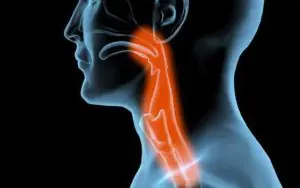
The throat is most vulnerable to various types of injuries, including burns, since its delicate tissue structure is highly sensitive and can be easily damaged.
A burn in the throat is different in that it is internal and affects the larynx, palate and esophagus. The extent of damage depends on the severity of the injury. The burned area cannot be covered with a bandage, and the injured areas are difficult to reach for treatment. With this type of damage, the swallowing reflex may disappear for a long time, which will make it impossible to eat food naturally.
With such damage, the following are felt: Acute pain, increased salivation, increased body temperature, the affected area of the throat burns, the person may feel sick, dry cough, hoarseness, swelling of the affected area, swollen lymph nodes, lack of oxygen.
In very dangerous stages, bleeding wounds, blisters appear, the upper layers of tissue are severely damaged, painful shock and respiratory collapse may occur.
Causes
Thermal burn affects the throat when ingesting hot food or drink, and chemical burn when the throat is exposed to medications, alcohol, acids or chemicals.
The main causes of this type of damage are negligence and carelessness when interacting with hot liquids, food, as well as chemicals, alcohol-containing liquids and medications of a certain group.
Alcohol and alcohol. The risk group primarily includes socially vulnerable citizens suffering from addiction, who consume alcohol-containing liquids and low-quality alcoholic beverages for other purposes.
Damage from alcohol-containing liquids occurs if the alcohol concentration in them is more than 70 percent. This is the easiest type of lesion, since a membrane forms on the mucous membrane that does not allow alcohol to penetrate deep into the surface layer of the epithelium. If alcohol penetrates into the esophagus, a white coating of dead tissue cells appears on its internal surfaces.
The injury is accompanied by the following manifestations: pain in the chest and cervical region, weakness appears in the stomach, and the sensitivity of taste buds is dulled.
Hospitalization, if the esophagus is not damaged, is not required and after some time the tissue cells will recover on their own.
Hot food and liquid. Most often, the throat is burned by hot tea or food, as well as by inhalation of hot steam. Thermal burn of the throat occurs in most cases and does not pose a great danger if it does not penetrate into the deep layers of the mucous membrane. But it all depends on the temperature of the food, steam or drink ingested and on the time of action of the hot agent.
Children are most susceptible to these types of injuries. Therefore, to prevent a child from getting a burn on the palate from hot food, you should always check the temperature of the food served on the table.
There are three degrees of burn injury:
- First degree. Acute pain, the mucous membrane turns red.
- Second degree. The appearance of a gray-white plaque with liquid blisters.
- Third degree. Tissue death is observed.
The first and second degrees of severity are the most common and with proper treatment, regeneration of damaged areas occurs quickly. Grade 3 is very rare, it is the most difficult and can only be treated in a hospital.
Burn of the larynx by gastric juice. In diseases accompanied by the release of bile, you can get injury to the larynx caused by gastric juice.
Symptoms of damage: sharp pain, irritation of the mucous membrane, a feeling of chest compression, gag reflex, heartburn, increased formation of bile after eating heavy food.
Chemical burn and its signs
Chemicals such as acids and alkalis, as well as their vapors, if they enter through the oral cavity or nasopharynx, cause this type of injury. You should also be very careful with medications, for example, iodine or Lugol, which can cause chemical damage.
Chemical injuries are more dangerous than thermal ones, since after ingestion they have a destructive effect on tissue cells for a long time. The general symptoms of the chemical type are basically the same as for thermal injury: acute pain, the mucous membrane becomes red, and a strong burning sensation is felt.
When lubricating the throat during inflammation of the tonsils, there is a chance of getting a throat burn with Lugol if it is highly concentrated.
During radiotherapy of the mucous membrane, if the dosage of the drugs is not observed, a burn from electrophoresis is possible. To prevent this from happening, you must know the list of contraindications for this procedure.
A burn of the larynx by gastric juice also refers to a chemical type of injury, but is classified as a separate type.
First aid for burns of the trachea and throat
It is advisable for every person to know the procedure for emergency actions in case of a throat burn and what to do in such cases, as well as how and how to treat it.
Providing first aid consists, first of all, of quickly and competently providing it, a lot depends on it. The more quickly it is provided, the faster and easier the treatment will be.
First of all, the patient must be given cool water to drink. Afterwards you need to treat the affected area with an anesthetic.
If the injury is caused by acid, then you need to dilute 2 grams of baking soda in a liter of water and give this solution to the injured person to drink.
In case of damage due to exposure to alkali, for oral administration you need to dilute 3 grams of acetic or citric acid in a liter of water
First aid for a throat burned by iodine is simple. It is enough to rinse for 15 minutes with boiled water at a temperature of 16-18 degrees, and then apply a sugar solution to the damaged area.
In the room, you need to open a window to let air in and call an ambulance.
Further treatment
Treatment at home. Treatment of such ailments in a mild form can be carried out at home, since there is no threat to the life and health of the victim, and the treatment is not complicated.
1st and 2nd degree burn injuries to the throat are not very dangerous and can be easily treated at home. It can be treated both with the use of medications and by resorting to folk remedies. Typically, rosehip oil is used, and when gargling, soothing, healing herbs are used. But still, before treating a burn in the throat, it is strongly recommended to consult a doctor.
Means for treating a burn of the larynx with boiling water.
In this case, drugs of the following types are used: almagel, phosphalugel, de-nol, rennie, methyluracil, motilium, gaviscon, vitamins A and E, lanza and nolpaza.
All these drugs are available, but consultation with a doctor is necessary.
Hospital treatment. The most dangerous injuries of this type are classified as third degree and are treated only under the close supervision of doctors and only in a hospital.
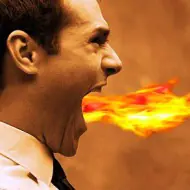
A throat burn is an injury to the mucous membrane of the throat caused by the destructive effects of chemical or thermal factors. The main cause of the pathology is simple carelessness. Burns occur accidentally in domestic or industrial conditions, as well as intentionally - during a suicide attempt. Industrial burns occur when inhaling vapors of chemical compounds while working without personal protective equipment, for example, without a respirator. Children are most susceptible to throat burns as a result of insufficient control over them, but they often occur in adults.
A burn of the larynx is a lesion of the epithelium, and in severe cases of deep-lying tissues: muscles, ligaments, cartilage. The consequences of such pathologies are very dangerous for humans.
Chemical or thermal damage to the larynx causes immediate pain and requires immediate medical attention and adequate correction.
Minor burns may not be treated, since the epithelium of the mucous membrane of the upper respiratory tract has the ability to quickly repair itself. Severe injuries can lead to disability and even death.
Depending on the type of etiopathogenetic factor involved, throat burns are classified into chemical and thermal. Symptoms and methods of providing first aid for these ailments are somewhat different.
Etiology
The causes of burns to the throat mucosa are divided into two large groups: chemical and thermal.
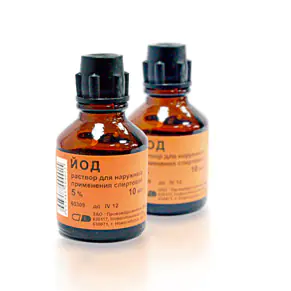
Chemical burn to the throat - a serious problem, the main cause of which in domestic conditions is alcohol or certain medications. Treatment of tonsillitis with iodine solution or alcohol tinctures can lead to a chemical burn of the throat mucosa. Iodine is an aggressive chemical that can cause serious tissue burns. "Lugol", "Yox" - medicines prepared on the basis of iodine. The use of these drugs in the presence of severe pharyngitis or tonsillitis can result in a burn of the mucous membrane. Specific substances that cause chemical burns include: citric acid, vinegar, ammonia, soda, acetone, acids and alkalis, ethyl alcohol. A burn of the larynx, accompanied by pain and burning, can be caused by the reflux of gastric juice into the esophagus during gastritis with high acidity. Acids cause coagulation of muscle proteins and the formation of a dry scab, which is an obstacle to further penetration of the chemical. Alkalis have a more aggressive effect on the laryngeal mucosa. They dissolve proteins. In this case, wet necrosis develops, allowing chemicals to penetrate inside.- Thermal burn of the larynx occurs when consuming hot food and boiling water, as well as when inhaling hot air, for example, during fires. Many burn blisters appear on the oral mucosa. At the same time, the victim develops vision problems, general health worsens, and the functioning of internal organs is disrupted. This is a milder form of pathology compared to chemical damage to the laryngeal mucosa, which is associated with short-term exposure to hot substances and their rapid neutralization with cool water.
Symptoms
A burn to the throat is manifested by intense and excruciating pain when swallowing, burning and painful sensations in the nasopharynx, profuse salivation, dyspeptic disorders, fever, swelling and redness of the mucous membrane, the appearance of blisters and areas of whitening on it, enlarged and painful lymph nodes, changes in the timbre of the voice, cough , shortness of breath, rapid heartbeat.

Burn injuries often spread from the larynx to the lower parts of the respiratory system: the trachea and bronchi. At the same time, the general condition of the patients worsens significantly. Trauma to the esophagus is manifested by excruciating pain in the chest and epigastrium, prolonged hiccups, belching and heartburn. Simultaneous irritation of a large number of nerve endings leads to serious consequences - reflex cessation of breathing. In cases of severe burns, toxic shock occurs.
A local burn of the pharynx is manifested by internal discomfort and goes away on its own within a week. More serious injuries require consultation with a doctor and comprehensive treatment.
- Thermal burn of the larynx occurs when drinking hot liquid, food or inhaling hot air. A burn from boiling water cannot be isolated. It usually spreads to the mucous membrane of the mouth, esophagus, and trachea. The symptoms of the pathology develop rapidly and cause a lot of trouble. The victim experiences sharp and excruciating pain, hypersalivation, reflex vomiting and other characteristic clinical signs.
- Chemical burns are less common than thermal burns. but it is much more severe and less responsive to therapy. Throat burns from various chemicals are very dangerous for humans. Clinically, they manifest themselves with the same symptoms as thermal ones. When a chemical enters the respiratory tract, dysphagia and dysphonia occur, and respiratory functions are disrupted.
Based on the severity and severity of tissue damage, there are three types of throat burns:
- 1st degree burn It is characterized by damage to the surface epithelium, on which whitened areas appear, and after 2-3 days they begin to separate. Patients feel a burning sensation and slight pain in the throat.
- 2nd degree burn characterized by more serious tissue damage and the formation of blisters with gray films on the mucosa. By the end of the second week, the plaque separates, the blisters burst, and erosions appear in their place - sores. They heal with the formation of small superficial scars that do not cause organ dysfunction. Intoxication is added to the pain syndrome.
- 3rd degree burn manifests itself as severe intoxication of the body and copious purulent sputum caused by the death of inflamed tissues. Scabs appear on the mucous membrane, which over time are rejected to form large and deep bleeding ulcers. After they heal, a scar remains, disrupting the swallowing process.
Second- and third-degree throat burns are dangerous injuries. In the absence of timely medical care, the victim may die due to suffocation or intoxication.
Urgent Care
The prognosis of the disease depends on the quality and speed of emergency care. First, it is necessary to establish the damage factor by inspecting the scene of the incident and interviewing witnesses. Then they move on to inspecting the affected area. With acid burns, there is a dry scab on the mucous membrane, and with alkaline burns, there is a wet, jelly-like scab.
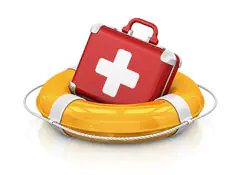
First aid for thermal burns involves drinking cool water, crushed ice, or gargling with anesthetic solutions.. Cold water will stop the burn from spreading into the tissue. You need to drink it in small sips, holding the water longer near the damaged area. Pieces of ice must be dissolved in the mouth. To reduce pain, you can take a solution of novocaine or lidocaine.- In case of a chemical burn, first aid is aimed at neutralizing acids and alkalis that have entered the body. For acid burns, use a solution of soda, and for alkaline burns, use a solution of citric or acetic acid. The patient should rinse the stomach, give a glass of milk and a little vegetable oil, and then call an ambulance.
To alleviate the patient’s condition, it is necessary to provide an influx of fresh air, maintain a silent regime, and exclude from the diet foods that irritate the affected mucous membrane and interfere with regeneration.
Treatment
It is necessary to treat 2nd and 3rd degree throat burns in a hospital setting. First degree burns are treated at home under medical supervision.
In the hospital, patients are prescribed the following groups of drugs:
- Painkillers – “Lidocaine”, “Trimecaine”, “Analgin”, painkillers pastes, narcotic analgesics “Fentanyl”, “Naltrexone”, “Promedol”.
- Sedatives – “Relanium”, “Persen”, “Valoserdin”, “Afobazol”.
- Detoxification therapy is carried out for deep burns - intravenous administration of glucose-saline solutions, Ringer's solution, Lasix.
- Broad-spectrum antibiotics and sulfonamides are used to prevent secondary infection. Typically, patients are prescribed drugs from the group of fluoroquinolones, macrolides, and the latest generation cephalosporins.
- Glucocorticosteroids to reduce swelling and relieve shock - Prednisolone, Hydrocortisone.
- Antiseptic solutions for rinsing - “Anestezin”, “Miramistin”, “Tantum Verde”, “Aqualor”.
- Antihistamines - Diphenhydramine, Calcium Chloride, Suprastin.
- Drugs that accelerate epithelization and tissue regeneration - “Aaevit”, “Retinol”, “Aekol”, “Solcoseryl”, “Methyluracil”.
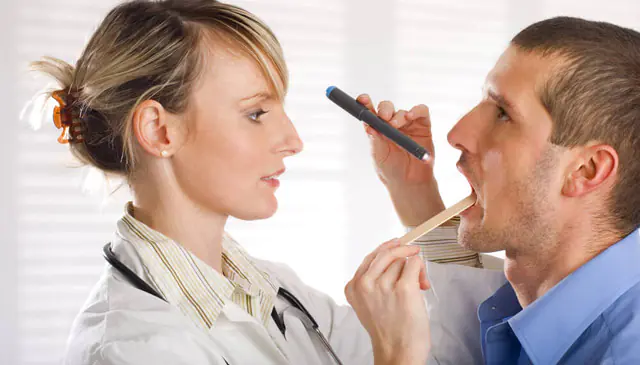
Experts transfer patients with a burn to the larynx to a gentle diet and recommend eating only soft, cool food in pureed form.
For the treatment of burns first degree They use traditional medicine, topical medications, and physiotherapeutic procedures:
- Gargling with decoctions of medicinal herbs,
- Cold compresses on the neck,
- Irrigation of affected tissues with peach or rosehip oil,
- Oil inhalations,
- Lubricating a sore throat with olive or sea buckthorn oil.
In severe cases, surgical methods are used to treat burns. Operations are performed when scars, ulcers, or serious deformities form, which lead to dysfunction of the affected organ.
Treatment of local burns gives a good result: the mucous membrane quickly regenerates. With 2nd and 3rd degree burns, tragic consequences may develop that can lead to disability and death of the victim.
Prevention
It is known that burn diseases of the larynx are usually the result of simple carelessness. To prevent this, you need to pay a lot of attention to preventive measures, be vigilant and extremely attentive.
- Small children should not be left unattended. Before giving your baby a bottle of formula, try it. Do not leave hot drinks, household chemicals and other chemicals within reach.
- Hazardous substances should be stored in specially designated areas out of the reach of children.
- People who are interested in alternative medicine can use prescriptions only after consultation with a specialist.
- It is necessary to follow safety precautions and know the rules of first aid.



